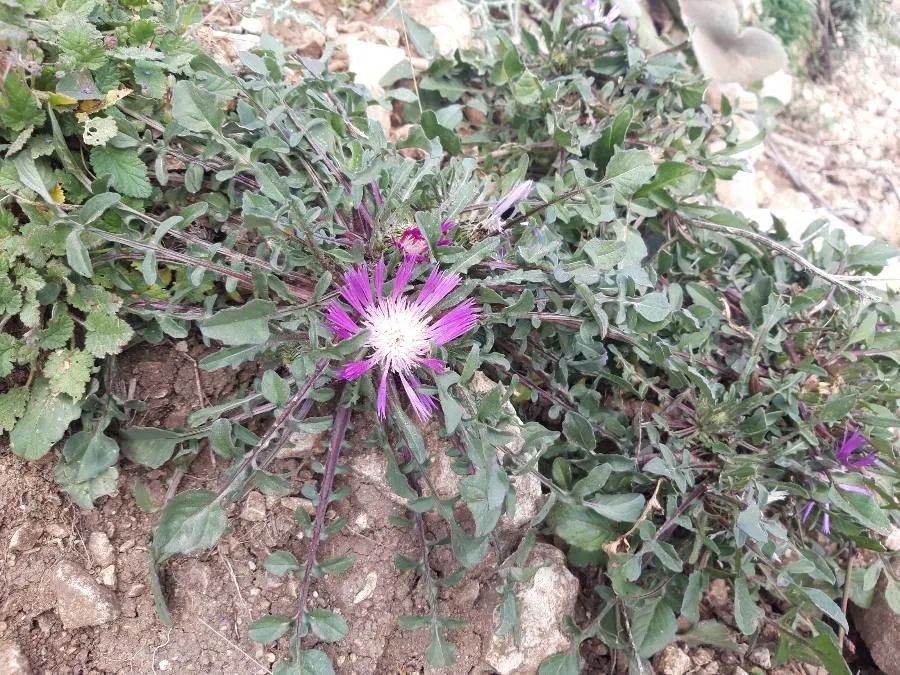
Author: L.
Bibliography: Sp. Pl.: 911 (1753)
Year: 1753
Status: accepted
Rank: species
Genus: Centaurea
Vegetable: False
Observations: W. & C. Medit.
Purple Knapweed (Centaurea pullata)
Purple knapweed, scientifically known as Centaurea pullata, belongs to the diverse and widespread Asteraceae family. This vibrant plant is a striking addition to the flora of the Western and Central Mediterranean regions.
Description:
Purple knapweed is distinguished by its vivid, thistle-like flower heads, which are typically a rich, purplish hue. These vibrant flowers are composed of numerous small florets, creating a dense, tufted appearance. The plant’s leaves are typically lance-shaped, exhibiting a subtle silvery hue due to fine hairs that cover the surface.
Habitat:
Thriving predominantly in the Mediterranean climate, purple knapweed is well-adapted to the warm, dry summers and mild, wet winters characteristic of this region. It often grows in rocky, open spaces and along grassy meadows, where it can receive ample sunlight.
Ecological Importance:
As a member of the Asteraceae family, purple knapweed plays a crucial role in its ecosystem. It serves as a valuable nectar source for a variety of pollinating insects, including bees and butterflies. This makes it an important plant for maintaining pollinator populations and supporting biodiversity within its native habitat.
Historical Context:
Centaurea pullata was officially described and documented by the renowned botanist Carl Linnaeus in 1753. Since then, it has been studied and appreciated for both its ecological value and its aesthetic appeal.
Uses and Cultural Significance:
While primarily appreciated for its beauty and role in nature, purple knapweed also holds cultural significance in some Mediterranean regions. It is sometimes used in traditional medicinal practices, though its application varies by locality.
In conclusion, purple knapweed (Centaurea pullata) is more than just a pretty plant. It is a vital component of Mediterranean ecosystems, supporting pollinators and adding to the biodiversity of its native regions. Its richly colored flowers and ecological importance make it a plant worth studying and preserving.
Fra: centaurée bordée de noir, centaurée en deuil
En: Purple Knapweed
Ar: مرار (مُرار)، مرير (مُرير), مرير (مُريْر)، مرور (مرّور)
Ca: Sarpa de llop
Fr: Centaurée bordée de noir, Centaurée en deuil
Taken Mar 5, 2020 by Luis Almeda (cc-by-sa)
Taken May 23, 2018 by Jose Manuel Gutierrez (cc-by-sa)
Taken Jan 31, 2019 by Carlos Ruiz Fernandez (cc-by-sa)
Taken Mar 1, 2019 by Pedro Díaz González (cc-by-sa)
Taken Mar 27, 2019 by camomila (cc-by-sa)
Taken Feb 3, 2022 by Avivar Laura (cc-by-sa)
Taken May 12, 2020 by Karim BOUDANI (cc-by-sa)
Taken Dec 19, 2020 by Montero de Espinosa Miguel (cc-by-sa)
Taken Jun 14, 2022 by Acosta García Isabel (cc-by-sa)
Taken Apr 28, 2022 by Sanchez Manuel (cc-by-sa)
Taken Apr 23, 2016 by Tela Botanica − Liliane ROUBAUDI (cc-by-sa)
Taken May 12, 2020 by Karim BOUDANI (cc-by-sa)
Taken Jun 14, 2022 by Acosta García Isabel (cc-by-sa)
Taken Apr 28, 2022 by Sanchez Manuel (cc-by-sa)
Taken Feb 9, 2020 by Muñoz Felipe (cc-by-sa)
Taken Dec 9, 2019 by thierry vidoy (cc-by-sa)
Taken Mar 22, 2021 by Ravi romarin (cc-by-sa)
Taken Feb 12, 2022 by Corsan Josema (cc-by-sa)
Taken May 7, 2019 by L M (cc-by-sa)
Taken Feb 1, 2022 by Monteiro Henrique (cc-by-sa)
Taken Mar 15, 2007 by Photoflora – Benoit BOCK (©)
Taken Apr 15, 2009 by Photoflora – Benoit BOCK (©)
Taken Feb 15, 2006 by Photoflora – Jean-Luc TASSET (©)
Taken Jan 1, 1970 by Photoflora – L’Abbé COSTE (©)
Taken Feb 22, 2022 by Renaud Brochiero (cc-by-sa)
Taken Jun 7, 2021 by Lazo Alfonso (cc-by-sa)
Taken Mar 15, 2007 by Photoflora – Benoit BOCK (©)
© copyright of the Board of Trustees of the Royal Botanic Gardens, Kew.
© copyright of the Board of Trustees of the Royal Botanic Gardens, Kew.
Ph maximum: 7.5
Ph minimum: 7.0
Light: 8
Atmospheric humidity: 4
Bloom months: [‘may’, ‘jun’]
Soil nutriments: 4
Family: Myrtaceae Author: (F.Muell.) K.D.Hill & L.A.S.Johnson Bibliography: Telopea 6: 402 (1995) Year: 1995 Status:…
Family: Rubiaceae Author: Pierre ex A.Froehner Bibliography: Notizbl. Bot. Gart. Berlin-Dahlem 1: 237 (1897) Year:…
Family: Sapindaceae Author: Koidz. Bibliography: J. Coll. Sci. Imp. Univ. Tokyo 32(1): 38 (1911) Year:…
Family: Asteraceae Author: A.Gray Bibliography: Pacif. Railr. Rep.: 107 (1857) Year: 1857 Status: accepted Rank:…
Family: Fabaceae Author: Medik. Bibliography: Vorles. Churpfälz. Phys.-Ökon. Ges. 2: 398 (1787) Year: 1787 Status:…
Family: Aspleniaceae Author: (Cav.) Alston Bibliography: Bull. Misc. Inform. Kew 1932: 309 (1932) Year: 1932…